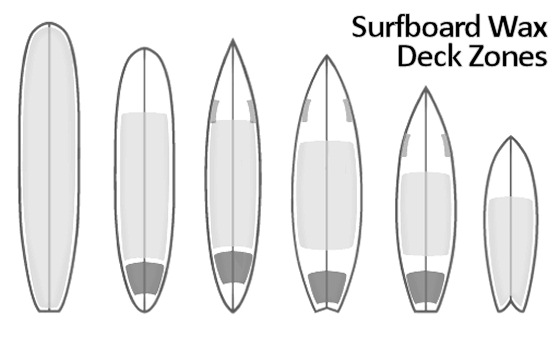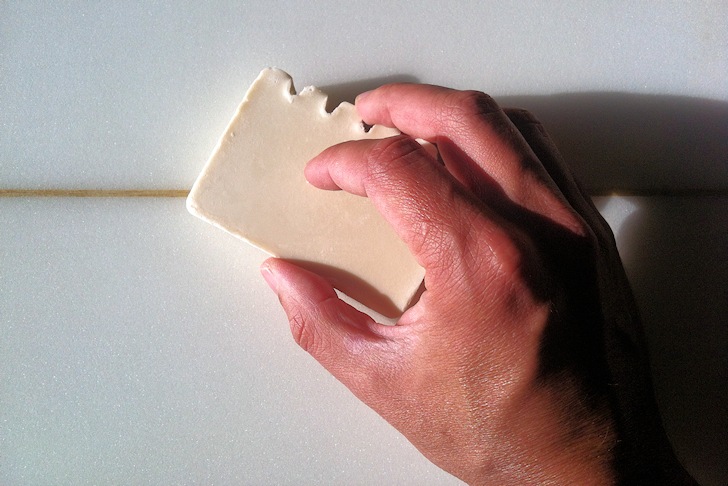Waxing a surfboard is easy, but the difference between a good and an excellent method could exponentially increase your grip. Learn how you can significantly improve adherence quality and reduce slipperyness with a few pre-surf actions.
The days when all a surfer did was paddle a heavy wooden longboard into shoulder-high waves and then apply a few long arch turns on the face are long gone.
Today, surfboard wax is more critical than ever.
Power surfers and new school aerialists demand a tight grip between their feet and the board, so faultless wax jobs are compulsory.
Vertical drops, airdrops, radical layback snaps, frontside airs, and fast barrels require time and technique waxing up the surfboard.
Nowadays, surf wax bars have been designed to meet a wide range of requirements.
The water temperature, the scent of the wax, and natural or synthetic materials may be selected according to a surfer's preferences and needs.
Applying a base coat of surfboard wax ensures you'll get a primary anti-slippery layer that will last longer than the top basic coat.
Some surfers also apply wax on the surfboard rails for extreme duck-diving and late take-offs.

Where to Apply Surf Wax
The first thing you need to figure out is where to wax the deck of your board.
The general rule of thumb is that wax should be applied in the working foot zones of the surfboard.
In the case of a shortboard, the region near the tail and above the leash plug should have at least a foot (30 centimeters) of a solid wax box so that the back foot is always covered.
For the front foot movements, the center area should have a good layer of grip - around three feet (90 centimeters) - so that you can move your foot up and down in the different moments of your ride.
It's always wise to add a little bit of wax to what you think is OK in case you need to move into unusual sections of the stick.
Generally, shortboards don't require a total waxed coverage above 75 percent. On the other hand, longboarders usually wax their entire boards or most of them.
In theory, you could think that it would just be better to cover the whole shortboard deck with a layer of grip.
The reason why this isn't practical is because wax adds unnecessary weight to the board.
Also, the more waxed area, the more drag as the board glides across the water.
Waxing Techniques
There are many valid surfboard waxing techniques: criss-cross, random, vertical, horizontal, oblique, and circular rubbing.
You should try them all and see which suits your riding needs better.
Just make sure you never apply new wax over an old, dirty, sandy, or less sticky layer.
Although there is no official wax application method, a good tip is to try to get a few horizontal strips of wax layered from the nose to the surfboard's tail.
This will prevent your feet from moving up and down inadvertently.
The Best Way to Wax a Surfboard
We at SurferToday.com have been waxing up all types of surfboards for over 30 decades, so we know what works and how to optimize the process.
Have you got a surfboard wax remover, base coat wax, and top coat wax? If so, you're ready to wax up your surfboard like a pro. Here's how to do it:
- Get yourself a surfboard wax remover, a base coat wax, a top coat wax, a surf comb, and a couple of paper towels;
- Remove old wax from the surfboard deck using the wax comb;
- Clean the remaining residue with a wax remover until your deck is glossy. Alternatively, some surfers also rub beach sand on the deck to absorb the remaining grease;
- Apply the base coat wax over the surfboard - using any wax job technique cited above - until you get small bumps;
- Get the right top coat wax for the water temperature you're surfing in and apply it on your board. Top-coat wax is soft and easier to apply once the base coat wax job has been completed;
- Level the uneven waxed zones to make sure there are no major bumps or small uncovered spots;
- If you wish, wax the board's rails where you usually grab for taking off on a wave;
In the next session, remember to comb your deck and add the extra layer of top-coat lost in the previous surf.
You should remove and clean all the wax on your surfboard every two months.
Surfboard wax loses its gripping properties over time, even if you don't surf regularly.
One last thing: new surfboards require more waxing time and thicker initial layers than previously used boards, so don't rush.
It's better to spend a few more minutes getting a good grip than falling or wiping out on great waves just because you wanted to get out the back fast.
Discover the best surf wax brands in the world.
Words by Luís MP | Founder of SurferToday.com
